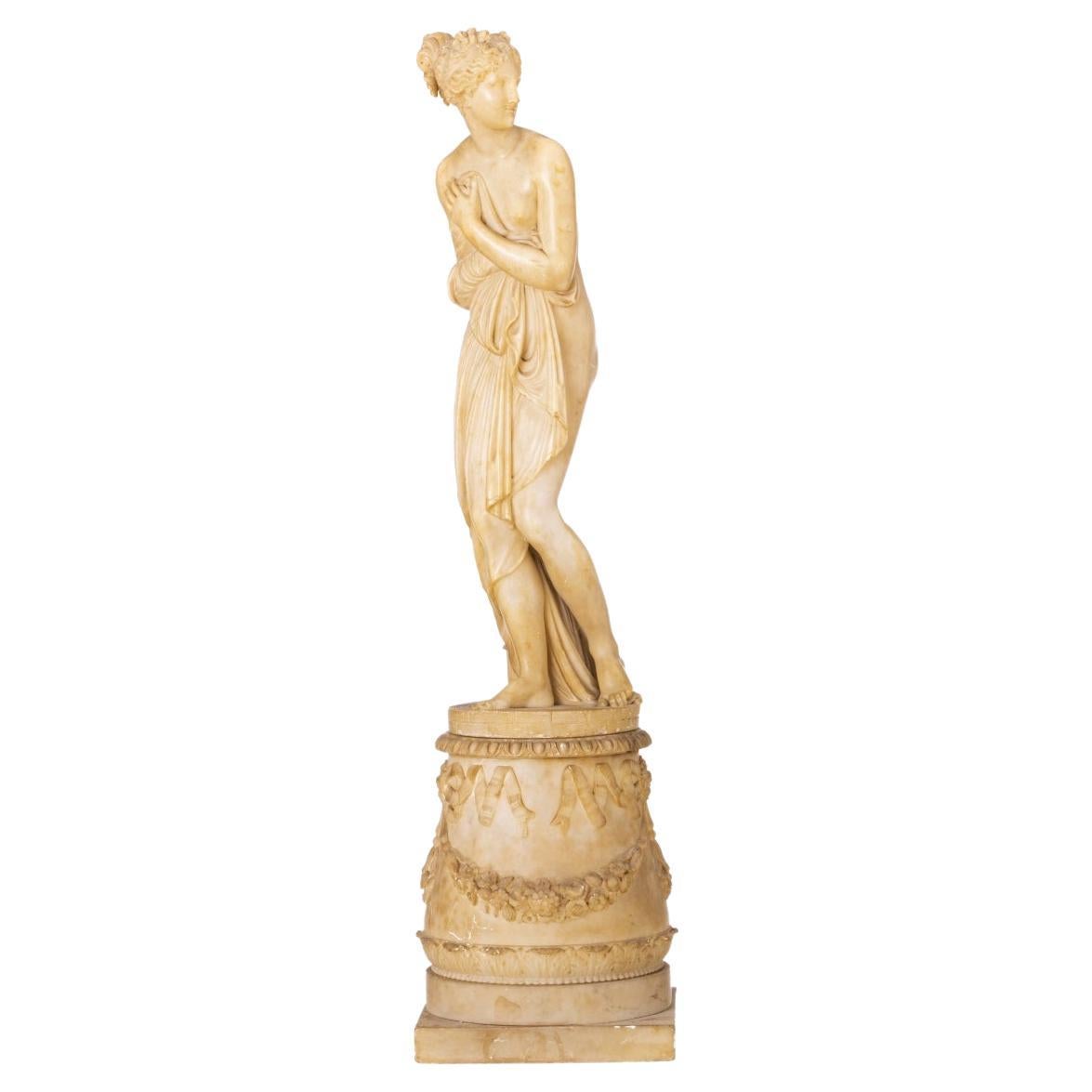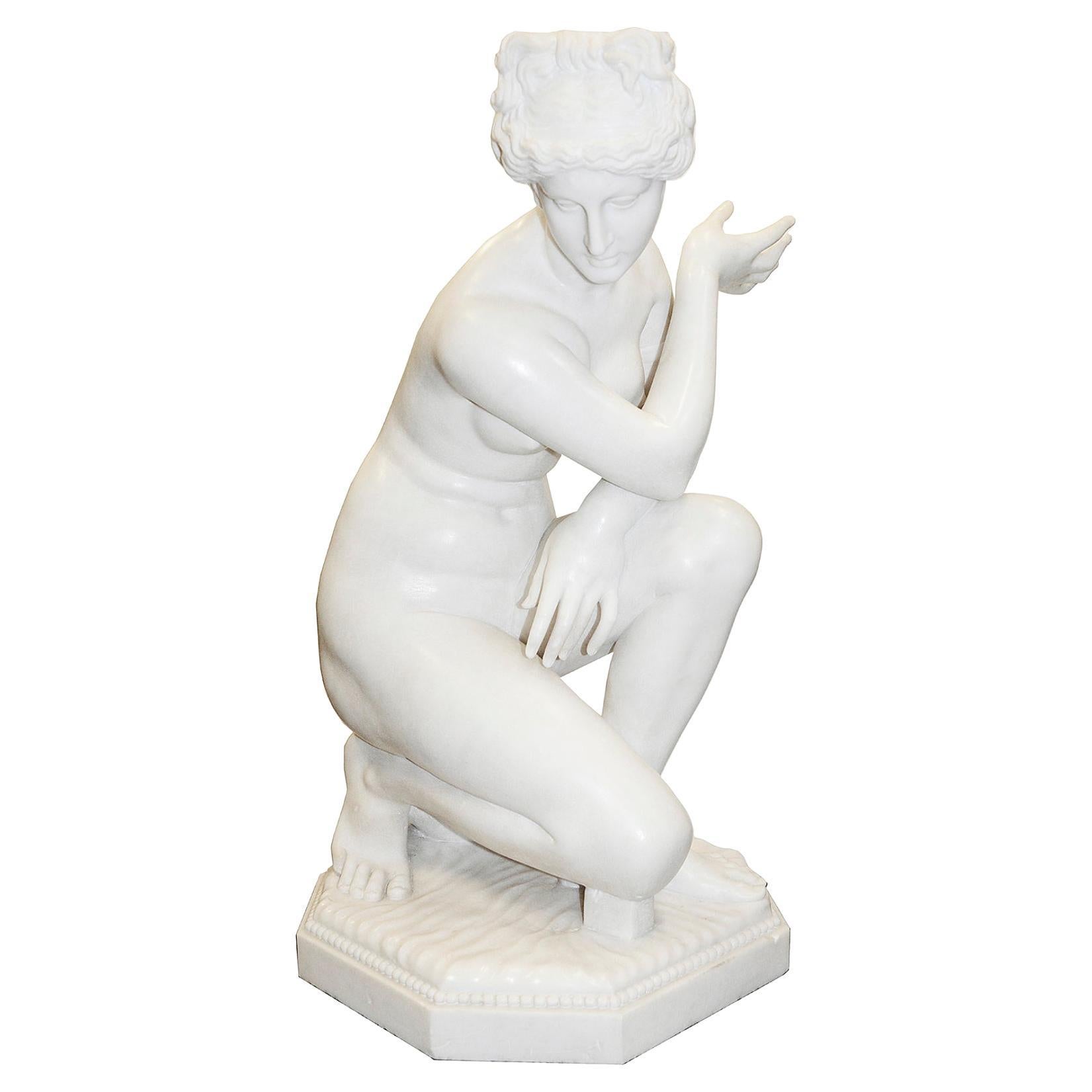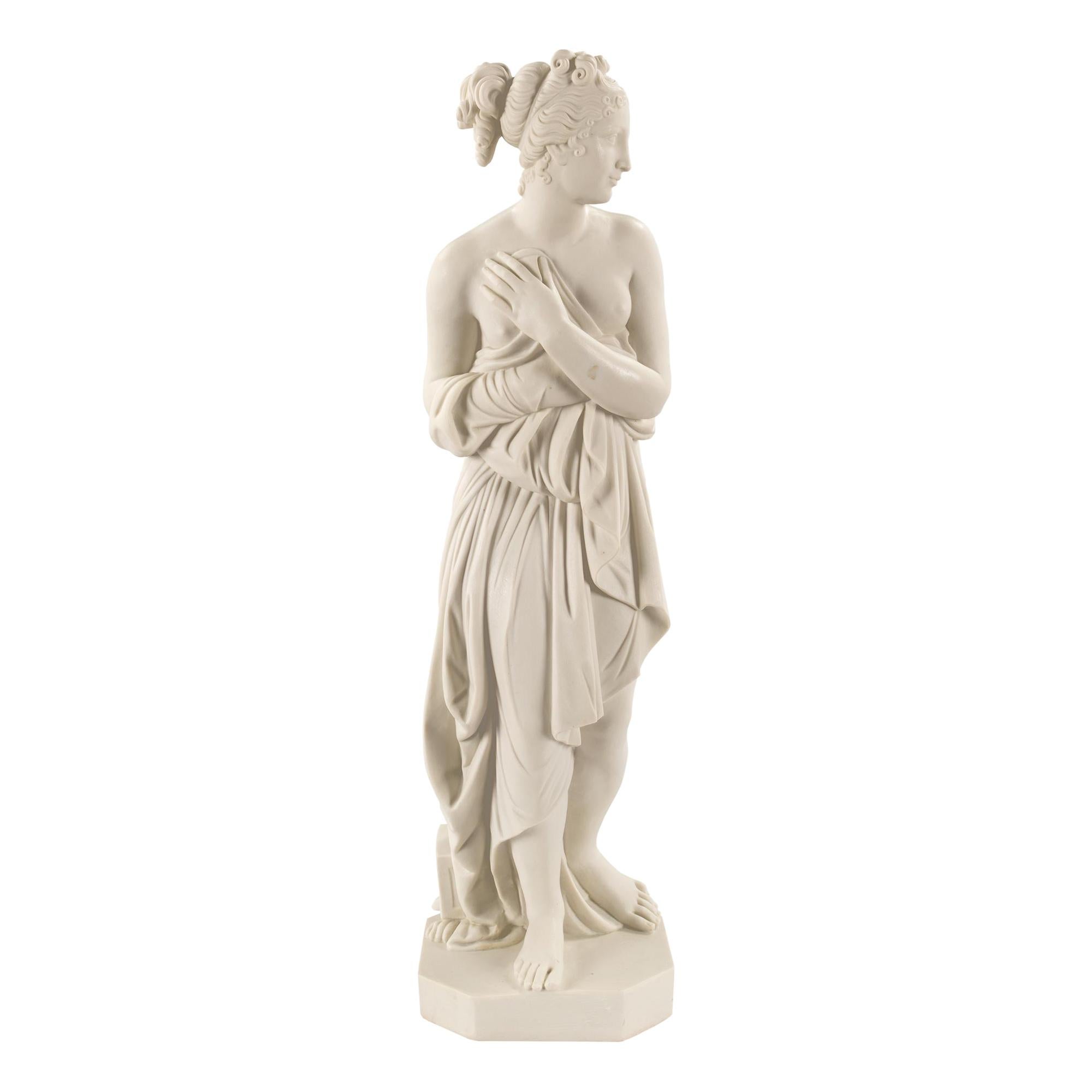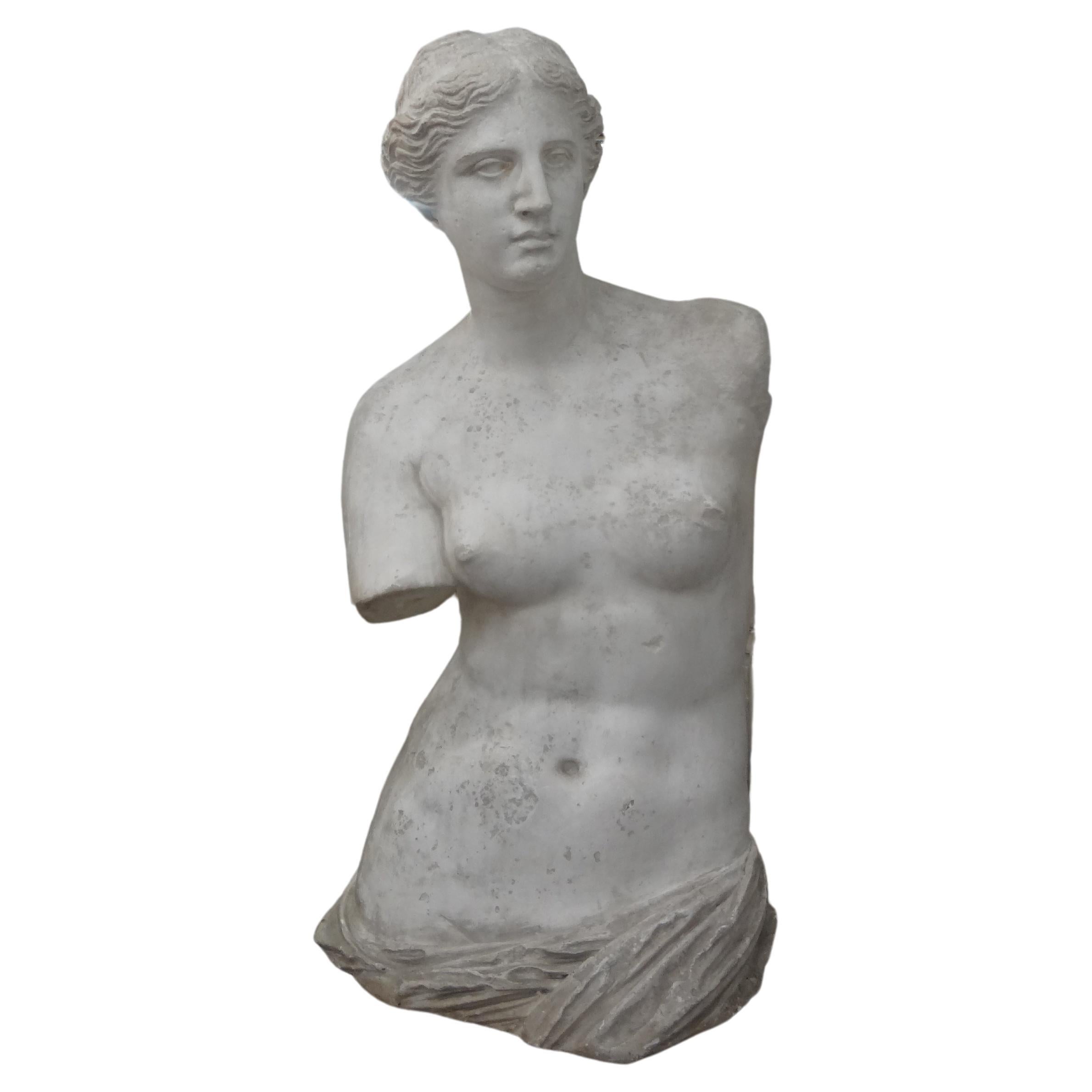Items Similar to Callipygian Venus - Italian, 19th Century
Want more images or videos?
Request additional images or videos from the seller
1 of 6
Callipygian Venus - Italian, 19th Century
About the Item
Callipygian Venus
19th Century
Italian (Naples or Rome)
White marble
After the Antique: Naples Archaeological Museum (IT)
Roman version of a Hellenistic 3rd Century B.C. model
Height: 62 cm
Width: 22 cm
H 24 1/2 x W 8 2/3 inch
The Callipygian Venus, also known as the Aphrodite Kallipygos or the Callipygian Venus, all literally meaning “Venus of the beautiful buttocks”, is an Ancient Roman marble statue, thought to be a copy of an older Greek original.
In an example of anasyrma, it depicts a partially draped woman, raising her light peplos to uncover her hips and buttocks, and looking back and down over her shoulder, perhaps to evaluate them. The subject is conventionally identified as Venus, though it may equally be a portrait of a mortal woman.
The marble statue extant today dates to the late 1st century B.C. The lost Greek original on which it is based is thought to have been bronze, and to have been executed around 300 B.C., towards the beginning of the Hellenistic era. The provenance of the marble copy is unknown, but it was rediscovered, missing its head, in the early modern era. The head was restored, first in the 16th century and again in the 18th century (in which case the sculptor followed the earlier restoration fairly closely); the restored head was made to look over the shoulder, drawing further attention to the statue’s bare buttocks, thereby contributing to its popularity. In the 17th and 18th centuries, the statue was identified as Venus and associated with a temple to Aphrodite Kallipygos at Syracuse, discussed by Athenaeus in his Deipnosophists.
The statue was copied a number of times, including by Jean-Jacques Clérion, François Barois and by multiple anonymous sculptors, like this statue.
- Dimensions:Height: 24.41 in (62 cm)Width: 8.67 in (22 cm)Depth: 4.73 in (12 cm)
- Style:Neoclassical (Of the Period)
- Materials and Techniques:
- Place of Origin:
- Period:
- Date of Manufacture:19th Century
- Condition:
- Seller Location:Bruxelles, BE
- Reference Number:1stDibs: LU6666236515292
About the Seller
5.0
Vetted Seller
These experienced sellers undergo a comprehensive evaluation by our team of in-house experts.
1stDibs seller since 2022
6 sales on 1stDibs
Typical response time: 7 hours
- ShippingRetrieving quote...Ships From: Bruxelles, Belgium
- Return PolicyA return for this item may be initiated within 3 days of delivery.
More From This SellerView All
- Venus Pudica (Medici-type) - 18th century, ItalyLocated in Bruxelles, BEMonumental sculpture representing the Venus Pudica (Medici-type) 18th Century Italian (Rome) White marble Based on a model from Antiquity, the Medici Venus, currently in the Uffizi ...Category
Antique Early 18th Century Italian Grand Tour Figurative Sculptures
MaterialsMarble
- Cerberus, Italy, 17th CenturyLocated in Bruxelles, BECerberus Black painted stone Italy, 17th century Measures: 80 x 69 x 36cm (one head missing) Cerberus, cruel monster, fierce and strange, Through his wide threefold throat barks as a dog Over the multitude immers'd beneath. His eyes glare crimson, black his unctuous beard, His belly large, and claw'd the hands, with which He tears the spirits, flays them, and their limbs Piecemeal disparts (Dante, Inferno, Canto VI). Cerberus figure seated, in his role of ferocious guardian of the underworld; he shows a nervous musculature, an adherent skin which reveals the ribs, long and robust limbs; his heads are broad and the eyes set well apart. Painted in black to amplify his menacing look, the infernal guardian is depicted with his famous attributes, writhing his heads, growling and barking furiously. Cerberus, in Greek mythology, was the monstrous watchdog of the underworld – also known as the “hound of Hades” – preventing the dead from leaving, and making sure that those who entered never left. A child of Typhon and Echidna, he was part of a monstrous family, which included Orthus, the Lernaean Hydra, and the Chimaera as well. Only on three occasions Cerberus was tricked by visitors of Hades: Heracles did it with his strength, Orpheus with his music. In "The Inferno", Dante places Cerberus as the guardian of the third circle of Hell. With his three mouths, Dante saw Cerberus as a beast that was synonymous with the sin of Gluttony. Virgil gets past the monster by throwing mud in his three mouths, temporarily choking him. Very rare are the representations of Cerberus in ancient statuary...Category
Antique 17th Century Italian Renaissance Figurative Sculptures
MaterialsStone
- Griffin Head, Italy, 16th CenturyLocated in Bruxelles, BEGriffin head Italy, 16th century On a modern metal stand Measures: 20 x 29 x 21 cm (without the stand) The griffin is a legendary creature with the body of a lion, the head an...Category
Antique 16th Century Italian Renaissance Animal Sculptures
MaterialsMarble
- Italian Memento Mori skull - 17th centuryLocated in Bruxelles, BEItalian Memento Mori skull Marble North of Italy, 17th century H 9 x L 7 x P 14 cm At the turn of the 16th century, they were the height of fashi...Category
Antique 17th Century Italian Renaissance Figurative Sculptures
MaterialsMarble
- Wax Relief, Italy 19th CenturyLocated in Bruxelles, BEWax relief depicting a vase with flowers Italy, mid-19th century Signed "Scot. inv et fecit" Measures: 37 x 44 x 7,5 cm.Category
Antique Mid-19th Century Italian Early Victorian Wall-mounted Sculptures
MaterialsWood
- Alabaster Golgotha, Italy, 17th CenuryLocated in Bruxelles, BEAlabaster Golgotha Italy, 17th cenury Alabaster with traces of polychromy 16 x 10 x 9 cm The Golgotha (literally "Place of the Skull ») is a hill on the outskirts of the city o...Category
Antique 17th Century Italian Renaissance Figurative Sculptures
MaterialsAlabaster
You May Also Like
- 19th Century Grand Tour Bronze Sculpture “Callipygian Venus” of AntiquityLocated in Shippensburg, PAGRAND TOUR MODEL AFTER ANTIQUITY Naples, Italy (19th Century) "The Callipygian Venus" Sand-cast and patinated bronze signed foundry mark in the base "Fonderia Artistica Sommer Nap...Category
Antique 19th Century Italian Grand Tour Figurative Sculptures
MaterialsBronze
- Venus in Alabaster, 19th Century Italian SculptureBy Europa AntiquesLocated in Madrid, ESVENUS IN ALABASTER 19th Century Italian sculpture in alabaster, after a model by António Canova (1757-1882). Dec. height: 80 cm Go...Category
Antique Early 19th Century Italian Baroque Busts
MaterialsAlabaster
- 19th Century Italian Marble Statue of ' Crouching Venus'Located in Brighton, SussexA fine quality late 19th century carrera marble statue of ' Crouching Venus'. Marble statue of a naked Aphrodite crouching at her bath, also ...Category
Antique Late 19th Century Italian Classical Greek Figurative Sculptures
MaterialsCarrara Marble
- Italian 19th Century Neoclassical Style Biscuit de Sèvres Statue of VenusLocated in West Palm Beach, FLA beautiful Italian 19th century neoclassical style Biscuit de Sèvres statue of Venus. The masterfully sculpted statue is raised by a square base with cu...Category
Antique 19th Century Italian Neoclassical Figurative Sculptures
MaterialsPorcelain
- 19th Century Italian Classical Marble Bust of Venus ChiurazziLocated in New York, NYPsyche of Capua. White marble bust of Venus, after antique. Italy, late 19th century. Inscribed, 'Chiurazzi.' Measures: 21 in. (53.3 cm) height.Category
Antique Late 19th Century Italian Classical Greek Busts
MaterialsCarrara Marble
- Monumental 19th Century French Plaster Torso of VenusLocated in Houston, TXMonumental 19th century French plaster Torso of Venus. This stunning large scale late 19th century French plaster torso sculpture of Venus is well exec...Category
Antique 19th Century French Neoclassical Figurative Sculptures
MaterialsPlaster
Recently Viewed
View AllMore Ways To Browse
Late Neoclassicism Lyre
Gary Baseman
Art Deco Skyscraper Sculpture
Neapolitan Crown
Daum Nude
Italian Ceramic Fruit Topiary
Child And Child Wing
Child Of Child Wing
Bronze Man Roman
Voltaire Sculpture
Hudson Bay Chairs
Fragmented Roman Torso
Art Deco Chrysler Sculpture
Bredow Rosenthal
Frances Serber
Large Bronze People
Head Covering
Bronze Sculpture Of King





